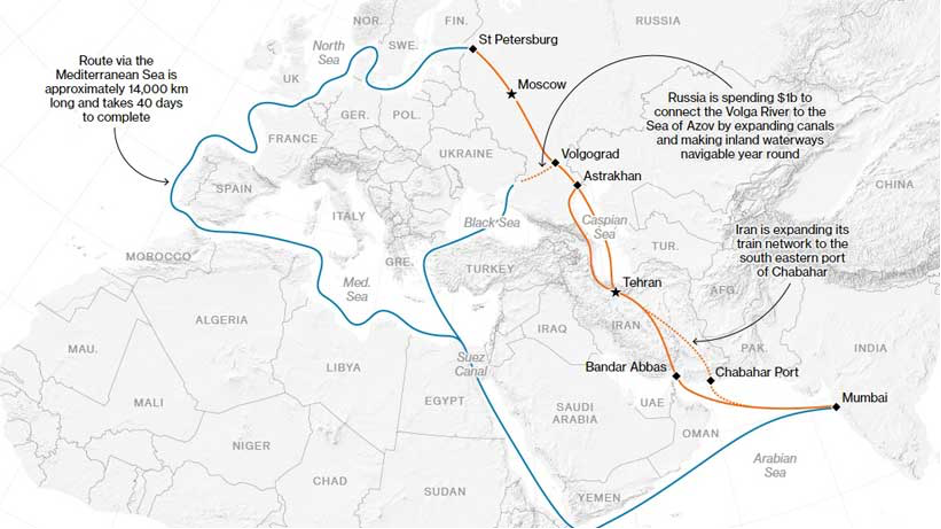According to a Bloomberg article on December 21, 2022, Russia and Iran are building a new trade route to defy sanctions (see Map 1). The route is expected to stretch from the eastern edge of Europe (Ukraine) to the Indian Ocean, a 3,000-kilometer passage that will be beyond the reach of any foreign meddling. The two countries are spending billions of dollars to build road, ship, and rail infrastructure along the route that will provide Russian Companies opportunities to enter the markets of Iran, India and Asia as well as the Middle East. Earlier in December 2022, Russian President Vladimir Putin said that the Sea of Azov “has become an inland sea” for Russia. From this sea, river, sea, and rail networks are expected to extend to Iranian hubs on the Caspian Sea and then to the Indian Ocean.
Map 1: Russian-Iranian Trade Route to Defy Sanctions

Source: Bloomberg.
There are number of Russian and Iranian considerations and motives behind forming this trade route as well as strategic implications stemming from it. Firstly, both countries have been hit with harsh sanctions, which have had a devastating impact on their respective economies. Both need avenues to defy sanctions and deal with restive populaces, especially as Russia is continuing with its war in Ukraine, and Iran continues to squander the resources of the Iranian people on its expansionist aspirations and faces a domestic uprising, which does not seem to be fading away. Turning eastwards has been often spoken of by Iranian officials, and the Raisi government made it a priority to pivot eastwards and forge closer relations with its neighbours and Asia. The Russian shift is also driven out of necessity, and Moscow is seeking refuge in the East and in China to counter Western efforts to isolate it, and defy Western sanctions. Finally, Russia and Iran are aware that a land corridor is much more difficult for the West to track and monitor unlike sea routes, thus providing both countries with a sanction-proof route to transport weapons and commodities between each other and to other markets as well. Secondly, the Russians, Iranians and Chinese defy the Western order and seek changes to the current rules of the game. This route adds to this end by providing a corridor that is independent of the West, and knits together nicely Asia and Central Asia; huge economic markets for the goods of these three countries. This Russia-Iran-China triangle, despite its complexities, is a dangerous axis for the West, because it has the potential of upsetting and threatening Western interests across the Middle East, Asia, and Central Asia. All three countries have been driven together because of pragmatic considerations, and with Western hostility toward the three countries unlikely to abate soon, one can expect more trade, economic and military projects between this triangle, defying further the Western order and its arrangements. Third, this corridor will further strengthen relations between Russia and Iran, with both needing one another for multiple reasons in the context of countering sanctions and international isolation. Given this trajectory of relations, regional and international efforts to confront Iran are highly likely to be impeded because of Russia’s support for Tehran in international forums. Moreover, Russia sees Iran as part of its geopolitical map; hence, any harming of Tehran is likely to negatively impact its geopolitical aspirations. Iran is carefully nestling itself between Russia and China, as a defensive strategy, to ease off Western pressures and attempts to force it to submit to a new nuclear deal. Fourth, this trade route is an example of how great power rivalry is shaping relationships and trade networks in a global economy that is set to fragment into rival blocs and alliances that will pose a challenge to the US-led unipolar world order. The goal will be to shield commercial links and corridors from Western reach and interventions, and to develop economic infrastructure that connects the economies of Asia and Central Asia with Russia and China acting as the kingpins. Given Iran’s proximity and natural linkages to many of these economies, Moscow and Beijing will rely heavily on it to play a significant role in developing new trade networks and linkages, with it acting as the heart of Russia’s and China’s grand geopolitical plan. To conclude, this trade route is a significant development as will provide a much-needed outlet for Russia and Iran to defy Western sanctions to reset their economies and importantly, an avenue for both to boost their defence ties, with Moscow having a free-hand to transport arms to Iran, and vice versa. With Iran supplying drones and medium-range missiles to Russia to help in its war effort in Ukraine, this supply will be ratcheted up via this trade route, with the West having no tools to deter this from happening. The route also poses strategic challenges to the United States, given that it will provide easy linkage points to China, and aid the process of weaving together a geopolitical map that heavily favors Moscow and Beijing at the expense of American interests.
